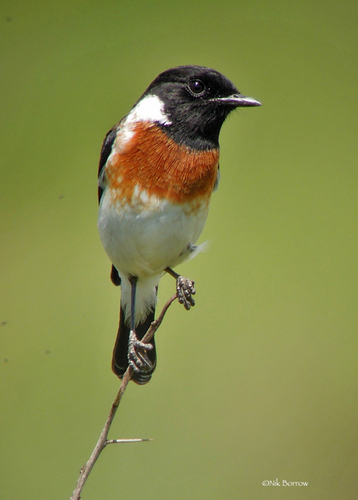
African Stonechat
The African Stonechat (*Saxicola torquatus*) is a small, striking passerine bird belonging to the Old World flycatcher family. It is a common resident of sub-Saharan Africa, known for its distinctive plumage and perching behavior. Ecologically, it plays a role in insect control, often found in open grasslands and agricultural areas. Unlike some stonechat species, the African Stonechat displays significant regional variation in plumage, leading to ongoing taxonomic debate about subspecies classifications. It holds no particular widespread cultural significance, but its conspicuous presence makes it familiar to many people across its range.
11.5-13 cm
Length
18-21 cm
Wingspan
Least Concern
Conservation Status
Distribution
Widespread across sub-Saharan Africa, from Senegal and Ethiopia south to South Africa. Absent from the driest deserts and dense rainforests. Also found on Madagascar and some surrounding islands. Some populations undertake local or altitudinal migrations, but it is generally considered a resident species.
Lifespan
Typically 2-5 years in the wild, although some individuals may live longer.
African Stonechat's Habitat
Habitat Types
Grasslands, Savannas, Open woodlands, Agricultural fields, Fynbos, Montane grasslands
Climate Zones
Tropical, Subtropical, Temperate
Adaptations
Prefers habitats with scattered perches such as shrubs, fence posts, or tall grasses, which it uses for hunting. Adapted to a wide range of altitudes, from sea level to over 3000 meters in some mountain ranges.
Variations
Numerous subspecies have been described (over 20), differing primarily in plumage coloration, particularly the extent of black and chestnut on the males. There is ongoing debate about the validity of some of these subspecies.
Appearance
Breeding Plumage
Males are more brightly colored than females, particularly during the breeding season. Breeding males typically have a black head, white half-collar, black back, and rufous-chestnut breast. Non-breeding males may have duller plumage. Females are generally browner, with streaked upperparts and paler underparts.
Seasonal Feather Changes
Some seasonal variation occurs, with plumage generally brighter during the breeding season and duller outside of it.
Sex Based Plumage Differences
Significant. Males are much more brightly colored than females.
Notable Features
Conspicuous white rump patch (visible in flight), White half-collar (in males), Upright perching posture
Diet and Feeding
Primary Foods
Insects, Spiders, Other small invertebrates, Occasionally small berries
Foraging Behavior
Typically hunts from a perch, making short flights to capture prey on the ground or in the air. May also glean insects from vegetation. Often observed 'flycatching' - sallying out from a perch to catch flying insects.
Specializations
No highly specialized feeding adaptations, but its perching and hunting behavior is well-suited to open habitats.
Seasonal Diet Variations
Diet may shift slightly depending on insect availability, with more berries consumed when insects are scarce.
Behavior
Social Structure
Generally found in pairs or small family groups. Not strongly territorial outside of the breeding season.
Communication
Variety of calls, including a harsh 'chak' alarm call, A short, scratchy song used during courtship and territorial defense, Visual displays, such as flicking wings and tail
Migration
Mostly resident, but some populations undertake local or altitudinal movements in response to food availability or weather conditions.
Territorial or Group Behaviors
During the breeding season, males defend territories against other males. Outside of breeding, may form small, loose flocks.
Conservation
Threats
Habitat loss due to agricultural expansion, Overgrazing, Pesticide use, Afforestation (planting trees in previously open habitats)
Protection Programs
Not subject to any specific large-scale conservation programs, but benefits from general habitat protection measures in some areas.
Local National Laws
Protected under general bird protection legislation in many countries within its range.
Population Trend
Stable
Population Estimates
Widespread and relatively common; no precise global population estimate available, but considered to be in the millions.
Interesting Facts
The African Stonechat complex was previously considered part of a larger 'Common Stonechat' species.
Recent taxonomic revisions have split this group into several distinct species, including the African Stonechat.
They are known for their habit of perching on prominent objects.
This behavior gives them a good vantage point for spotting prey.
The name 'stonechat' refers to their call.
The call is said to resemble two stones being struck together.
Faqs about African Stonechat
What is the difference between a male and female African Stonechat?
Males have a black head, white half-collar, and rufous breast, while females are much browner and less strikingly marked.
Where can I see an African Stonechat?
They are common in open grasslands, savannas, and agricultural areas throughout sub-Saharan Africa.
Are African Stonechats migratory?
Most populations are resident, but some may undertake local movements in response to food availability.
Are African Stonechats endangered?
No. The IUCN lists the African Stonechat as 'Least Concern'.
Copyright @ Nature Style Limited. All Rights Reserved.
 English
English